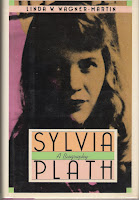The Wagner–Martin mss., ca. 1962–1991 at the Lilly Library of Indiana University, consist of the correspondence and papers of poet, biographer and English professor Linda Wagner–Martin. Included in the papers are research notes and materials, correspondence, interview notes, drafts of chapters, etc., relating to her biography of Sylvia Plath (Sylvia Plath: A Biography. New York: Simon and Schuster, 1987). Other significant files include correspondence with Denise Levertov relative to a book Wagner edited for New Directions Paperbacks, but which was later withdrawn from distribution (Denise Levertov: In Her Own Province. New York: New Directions, 1979). Also present are correspondence files with Robert Creeley, James Laughlin, Joyce Carol Oates, Diane Wakoski, and Florence Williams (Mrs. William Carlos Williams).
Wagner-Martin's papers include photocopies of three letters from Sylvia Plath to Daniel and Helga Huws from 30 October 1961 (4 pages), March 1962 (late winter, between 12 March and 31 March) (1 pages), and 26 December 1962 (4 pages). These are all long, good newsy letters - much too long to sufficiently paraphrase, but in short they detail the layout of Court Green, their life settling-in in North Tawton (which she found to be an ugly town), the birth of Nicholas, and her move to Fitzroy Road and dealing with the fallout and realities of life after Ted Hughes. They show Plath communicating with friends and exhibit her dry and sarcastic wit, her eye for detail, and to a degree, being a casual, living human, mother, person. Sometimes when reading Plath's poems and prose, I forget that there are other facets to her life other than the things for which she is primarily known. It is refreshing to see her being social, witty and humorous.
Disclaimer: Aside from reading these great letters from Plath to the Huws', I have not worked with the Wagner-Martin collection. If someone reading this has, please leave a comment about it! I imagine there would be material in there, especially the research and interview notes, that might not have made it into the printed edition of the biography. In this way, the working papers of a biographer and critic are much like the working papers of a poet's poetry in draft. We pour over the worksheets of Plath's Ariel poems and those originated by Ted Hughes (and, naturally, other writers): to look for lost and deleted lines and imagery; to see how one poem relates to or was influenced by another; to see if a spark removed from one poem could often flare up into a poem of its own. These papers therefore might offer the raw reactions of the biographer, the subject, and acquaintances of the subject and yield nuggets of insight into Plath's life, times, and character.
You can see more libraries that hold Plath materials on the Archival Materials page of my website for Sylvia Plath, A celebration, this is.
All links accessed 25 September 2013.
Wagner-Martin's papers include photocopies of three letters from Sylvia Plath to Daniel and Helga Huws from 30 October 1961 (4 pages), March 1962 (late winter, between 12 March and 31 March) (1 pages), and 26 December 1962 (4 pages). These are all long, good newsy letters - much too long to sufficiently paraphrase, but in short they detail the layout of Court Green, their life settling-in in North Tawton (which she found to be an ugly town), the birth of Nicholas, and her move to Fitzroy Road and dealing with the fallout and realities of life after Ted Hughes. They show Plath communicating with friends and exhibit her dry and sarcastic wit, her eye for detail, and to a degree, being a casual, living human, mother, person. Sometimes when reading Plath's poems and prose, I forget that there are other facets to her life other than the things for which she is primarily known. It is refreshing to see her being social, witty and humorous.
Disclaimer: Aside from reading these great letters from Plath to the Huws', I have not worked with the Wagner-Martin collection. If someone reading this has, please leave a comment about it! I imagine there would be material in there, especially the research and interview notes, that might not have made it into the printed edition of the biography. In this way, the working papers of a biographer and critic are much like the working papers of a poet's poetry in draft. We pour over the worksheets of Plath's Ariel poems and those originated by Ted Hughes (and, naturally, other writers): to look for lost and deleted lines and imagery; to see how one poem relates to or was influenced by another; to see if a spark removed from one poem could often flare up into a poem of its own. These papers therefore might offer the raw reactions of the biographer, the subject, and acquaintances of the subject and yield nuggets of insight into Plath's life, times, and character.
You can see more libraries that hold Plath materials on the Archival Materials page of my website for Sylvia Plath, A celebration, this is.
All links accessed 25 September 2013.

